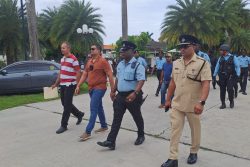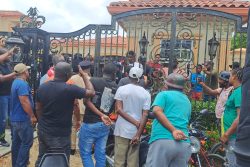One of the earliest records we have of Kingston, which is now Ward No.1 in Georgetown, appears in Dr. Pinkard’s “Letters” where he describes “An English village contiguous to fort and camp with neat, good houses, painted white, on brick foundations and covered with wallaba shingles.” This letter was dated April, 1796. It is generally agreed that the village was named after the capital of Jamaica.
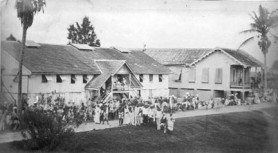
Kingston was the military centre of the Colony so, probably, the first people to build houses there were officers from the garrison. Here, also, lived the Garrison Chaplain, for many years the only English clergyman in the Colony. But men who had their business houses in the other township of Stabroek soon found it a good idea to make their homes in this pretty little village where they could enjoy the refreshing sea breezes, new houses, and interesting neighbours. Dr. Pinkard states that the rents paid for a house in Kingston at that time varied from ₤5 to ₤20 per month.
A visitor to the Colony during the late 18th century, driving up what is now High Street which in his day Dr. Pinkard describes as a good carriage road, would probably ask about a rambling building with broad galleries, built almost in the beach, on the site of the present Round House. This was Camp House, at one time the residence of the Governor.
North of Eve Leary, we read of two plantations, Kierfield and Sandy Point but, by 1804, these had been entirely washed away. The foreshore was covered with courida swamp with the exception of the strip extending from Fort William Frederick to Camp Street. This sandy stretch was the scene of many a duel fought by the gentlemen of the time and later of band concerts by the band of the West India Regiment. Horse racing could also be seen on the beach prior to the use of D’Urban Race Course in 1829.
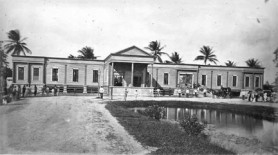
An interesting little building stood half a mile east of Fort William Frederick. This was the Block House which, besides serving as a signal station for vessels arriving, was a base for sending semaphore messages by relays along the East Coast to Berbice.
One hundred years ago
By 1848, the little village of Kingston had grown considerably. In 1830, the temporary wooden structure which had served as lighthouse from 1817 was replaced by the present lighthouse. Richard Schomburg, writing of his travels between 1840 and 1844, says:
“After climbing the 140 steps leading to the gallery, a wonderful panorama unexpectedly came into view. Dumb with surprise and delight, the eye swept over the heaving and billowy seas as far as the distant horizon where Earth and Heaven met; light fishing-boats pitched and tossed upon the ruffled waves, to disappear a moment later, while a ponderous coaster would skim its way through them. Below, there glared at me the thick forest of masts and flying flags. Spreading itself before my delighted gaze was the city with its nice, wooden, gaudily-painted houses, its overtopping churches and public buildings, its thousands upon thousands of slender palms, its broad busy streets, and its many canals that ran through it like so many veins.”
The same writer continues:
“Near the Fort rises the Lighthouse tower, east of which the beautiful but unoccupied Camp House, the residence of former Governors, who in those days were also the Troop-commanders, peeps clandestinely through the thick foliage of giant trees, the lovely, large and roomy Eve Leary Barracks are attached to it, and the two military hospitals border the immense parade ground… A shady alley-way of thickly-leaved trees and slender palms leads to the blessed God’s acre for the officers, the soldiers’ cemetery being on the farther side of the Barracks.”
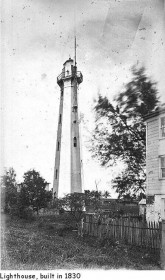
The barracks described here were erected in 1837. Rodway, in his “Story of Georgetown,” says that these fine, spacious barracks for troops had replaced the poor confined ones formerly in use, where soldiers were crowded to an unmerciful degree in hammocks.
The first and still the only church in Kingston is the Methodist Church which opened in 1831. The first chapel was a much smaller building than the present church but on the same site. The soldiers at the barracks often held church parade there and sailors and fishermen also helped to make up the congregation.
The first Bishop of Guiana, appointed in 1842, lived in “Kingston House” on the same site as the present “Austin House” but built nearer the road. “Austin House” itself was not erected until 1894.
In 1848, great excitement was caused by the opening of the railway Line from Georgetown to Plaisance. A few years later there was excitement of another kind when the population of Kingston began to be much concerned over the encroachment of the sea, and an earth dam was commenced along the shore. This, however, proved no barrier to the waters which, in 1855, flooded the whole of Kingston in places to a depth of four feet. The higher land at the railway line marked the boundary of the flood. Rodway states: “Camp House was abandoned, its stables and cowsheds swept away, the Lighthouse liable to be undermined.” A local rhymer of the time produced the following-
“Be sober, my muse, and with gravity tell
what sad havoc and ruin all Kingston befell,
How the sea swept away all-the dam and its smouses,
Made canals of the streets, Noah’s arks of the houses;
How some bridges blew up, how some houses came down,
And together went wandering over the town”.
That year, the building of the sea wall commented in earnest, as can be seen from the tablet west of the Round House on the Sea Wall, on which is the following inscription:-
This Sea Wall was commenced at the Battery,
A.D. 1855, and was completed to this point, A.D. 1860
The work continued for many years and, in 1882, was completed as far as Kitty. A second tablet east of the Round House records this.
In 1860, the Town Council erected two large tanks next [to] the Church to provide water for schools and poor people in times of drought.
The Governor’s Pond near the Sea Wall is probably a result of the practice of digging clay for sea defense dams. A suggestion that it should be filled in was altered and, in 1940, the sides were concreted instead. This pond has proved a great attraction for boys with model sailing boats and is a beauty spot on a moonlight night when the stately palm trees on the east side are reflected in the rippling water.
Kingston in 1948
During the last twenty-five years, much of the old Kingston has disappeared, and many changes have been caused by the Second World War. In 1924, what was left of Fort William Frederick was dismantled in order that the Petroleum Bond could be erected on the same site. Up to 1940, an imposing line of twenty-two cannons still provided an excuse for the name of “Fort” and, at the same time, were used as playthings by children, but the war came along, and twenty-one of them were sold to a Canadian munitions’ firm. One gun remains pointing out to the river. This is the “8 o’clock gun” which Schomburg mentions in his writing of more than one hundred years ago:
“Just as the firing of cannon had signaled the onset of night, a similar one notified the breaking of day; the Reveille sounded through the yet silent city streets and recalled to life fresh energies and renewed activities.”
This firing of a gun at 5 a.m. and 8 p.m. – a reminder of slave days – was discontinued in 1939 through the shortage of gunpowder. (The firing of the gun at 5 a.m. had stopped before that time.)
Formerly the offices of the Howard Humphreys Corporation, the bath hut east of the Bond was taken over by the Town Council for this purpose in the nineteen twenties or thirties. The former Immigration Depot near the sea wall was built in 1881 and the passer-by could always see in the compound crowds of East Indians who were staying there prior to their return to India. During the war, the building was taken over for military purposes. The bottom flat is at present used as the office of the District Commissioner, Georgetown.
Other points of interest of interest on the sea wall are the bandstand, erected by public subscription in 1903 as a memorial of her late Majesty Queen Victoria, and the Koh-i-noor Shelter nearby, which is the outcome of a memorial paper of the Diamond Jubilee edited by Miss Webber. An imposing memorial of the last war is a concrete pillar near the Round House on which used to be a small look-out shelter, complete with anti-aircraft gun. After the war, the pillar was left standing and the following inscriptions put on it.
“The Royal Regiment Artillery, B.G. Coast Battery, World War 1939-1945.”
Fifty years ago, it was not possible to get into Cowan Street from Fort Street. The road was blocked by an Old Dutch well, which has since been filled in, and the road built over. Perhaps it was this well which gave the name of Spring Alley to our Fort Street.
A building which has changed hands many times is the present Education Department which formerly housed the Public Works Department Head Office. The building has been used as military barracks and as a dwelling house. The north-east corner of this same site, now a promising kitchen garden, was formerly the site of Kingston Anglican School – dismantled many years ago.
During the war, the vacant piece of land near the Lighthouse was cleared of its large trees for the erection of the United States Organisation Headquarters, which caused an unusual amount of traffic in the district, especially on party nights. The building has since been taken over by the Government for use as the Public Works Department Head Office.
A landmark in Kingston is the huge molasses tank in Water Street which was erected by the Pure Cane Molasses Company in 1931. Next door is the Electric Company Power House, erected in 1937. Another interesting building is St. Joseph’s Mercy Hospital, formerly the private nursing home known as “Colonna House” and, before that, a dwelling house famous for its 99 windows.
Kingston, the “pretty little village” of 1796, is now a compact, built-in residential ward of the city of Georgetown. It has shared the improvements enjoyed by the rest of the city − better roads, tramcars while they lasted, first gas and now electricity. But a view of the city from the lighthouse to-day would not be very different from that described by Schomburg in 1840; and the houses in Kingston are still “neat good houses, painted white” as described by Dr. Pinkard.

